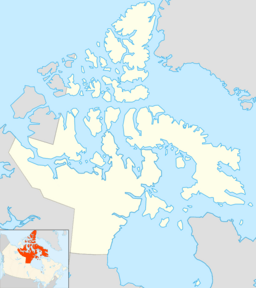Roes Welcome Sound facts for kids
Quick facts for kids Roes Welcome Sound |
|
|---|---|
| Coordinates | 65°01′N 086°40′W / 65.017°N 86.667°W |
| Basin countries | Canada |
| Max. length | 290 km (180 mi) |
| Max. width | 24 to 113 km (15 to 70 mi) |
| Settlements | Uninhabited |
Roes Welcome Sound is a long, narrow body of water in Canada. It is located in the Arctic, in a region called Nunavut. This sound acts like a channel, separating the mainland of Canada from a large island called Southampton Island.
Contents
Exploring Roes Welcome Sound
Where is Roes Welcome Sound?
Roes Welcome Sound is found at the northwest end of Hudson Bay. It is part of the Kivalliq Region in Nunavut, Canada. The sound opens south into Hudson Bay.
At its northern end, Roes Welcome Sound connects to Repulse Bay. Repulse Bay then links east through Frozen Strait to Foxe Basin. This connection is important because it makes Southampton Island a true island. A western branch of the sound is called Wager Bay. The sound is about 200 km (124 mi) north of Marble Island.
How Big is the Sound?
Roes Welcome Sound is quite long. It measures about 290 km (180 mi) from end to end. Its width changes a lot. At its narrowest, it is about 24 km (15 mi) wide. At its widest, it stretches out to about 113 km (70 mi).
The History of its Name
The sound was first reached by explorer Thomas Button in 1613. He called it 'Ne Ultra'. Later, in 1631, it was named after Sir Thomas Roe. Sir Thomas Roe was a friend and supporter of another explorer named Luke Fox. Fox was on an Arctic journey when the sound was named.
In 1821, Captain William Edward Parry was trying to find the Northwest Passage. This was a sea route connecting the Atlantic and Pacific oceans through the Arctic. Parry wrote about Roes Welcome Sound:
"On an inspection of the charts, I think it will also appear probable that a communication will one day be found to exist between this inlet (Prince Regent's) and Hudson's Bay, either through the broad and unexplored channel called Sir Thomas Roe's Welcome, or through Repulse Bay, which has not yet been satisfactorily examined."
He thought the sound might be a way to find the famous Northwest Passage.
Wildlife in the Sound
Roes Welcome Sound is an important place for animals. It is a common path for bowhead whales when they migrate. These large whales travel through the sound as they move between different feeding and breeding areas.
See also
 In Spanish: Roes Welcome Sound para niños
In Spanish: Roes Welcome Sound para niños


